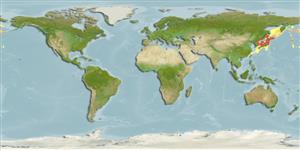>
Perciformes/Zoarcoidei (Eelpouts and pricklebacks) >
Zoarcidae (Eelpouts) > Lycodinae
Etymology: Bothrocara: Greek, bostrykos = cure of lack of hair + Tupí, guaraní, acará = the name of a fish. It could be also from Greek, kara = face (Ref. 45335).
Eponymy: Dr William Jacob Holland (1848–1932) was a Jamaican-born American Presbyterian minister, entomologist and palaeontologist. [...] (Ref. 128868), visit book page.
More on authors: Jordan & Hubbs.
Environment: milieu / climate zone / depth range / distribution range
Écologie
marin bathydémersal; profondeur 140 - 1950 m (Ref. 50550). Deep-water
Northwest Pacific: Sea of Japan and eastern Yellow Sea.
Taille / Poids / Âge
Maturity: Lm ? range ? - ? cm
Max length : 31.8 cm SL mâle / non sexé; (Ref. 11954)
Life cycle and mating behavior
Maturité | Reproduction | Frai | Œufs | Fécondité | Larves
Anderson, M.E., 1994. Systematics and osteology of the Zoarcidae (Teleostei: Perciformes). Ichthyol. Bull. J.L.B. Smith Inst. Ichthyol. 60:120 p. (Ref. 11954)
Statut dans la liste rouge de l'IUCN (Ref. 130435: Version 2024-1)
Menace pour l'homme
Harmless
Utilisations par l'homme
Outils
Articles particuliers
Télécharger en XML
Sources Internet
Estimates based on models
Preferred temperature (Ref.
123201): 0.3 - 3.5, mean 2.1 °C (based on 140 cells).
Phylogenetic diversity index (Ref.
82804): PD
50 = 0.5039 [Uniqueness, from 0.5 = low to 2.0 = high].
Bayesian length-weight: a=0.00282 (0.00146 - 0.00545), b=3.20 (3.03 - 3.37), in cm total length, based on LWR estimates for this (Sub)family-body shape (Ref.
93245).
Niveau trophique (Ref.
69278): 3.2 ±0.40 se; based on food items.
Résilience (Ref.
120179): Faible, temps minimum de doublement de population : 4,5 à 14 années (Preliminary K or Fecundity.).
Fishing Vulnerability (Ref.
59153): Low to moderate vulnerability (29 of 100).
